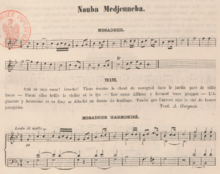You can help expand this article with text translated from the corresponding article in French. (December 2020) Click [show] for important translation instructions.
|
The sanâa or sanâa of Algiers (arabic: الصّنعة, ə-Ṣan'a) or simply the Andalusian, refers to the Algerian Arab-Andalusian classical repertoire of the school of Algiers,[1] and which tradition relates to the city of Cordoba in Al-Andalus.[2]
| Sanaa | |
|---|---|
 A Mseddar piece from the Nûba Mǧənba : Qum yā ḥabībī, by Alexandre Christianowitsch, 1863. | |
| Native name | الصّنعة ə-Ṣan'a |
| Etymology | Arabic for "embellished" or "craft(ed)" |
| Other names | School of Algiers |
| Stylistic origins | Algiers (Algeria) Cordoba (Al-Andalus) |
| Typical instruments | |
| Derivative forms | |
| Subgenres | |
| |
| Other topics | |
| The school of Tlemcen (san'a, gharnâta/i), the school of Constantine | |
Origin and meaning edit
Sanâa or san'a means “musical mastery”,[2] “embellished” or “craft(ed)”.[3] · [4] This is the specific name attributed in Algeria to the Andalusi nubah of Algiers, to be distinguished from the Gharnati of Tlemcen and the Malouf of Constantine.
However, the sanâa of Algiers shares many similarities with the Gharnati of Tlemcen. The schism between them occurred by 1946, with the creation of the Arab-Andalusian classical orchestra of Radio d'Alger.[2]
Features edit
Modes edit
The sanaa musical system is a modal system, based on sixteen modes (الطبع: Ṭabʿ, الطبوع: pl. tūbūb') which are divided into two main groups : principal modes, defined on the basis of seven istiḥbār (vocal and instrumental semi-improvisations), and derived modes.[5]
- Istiḥbār Mawwāl :
- Mawwāl (الموال)
- Dīl (الذيل)
- Raṣd ə-Dīl (رصد الذيل)
- Māya (الماية)
- Mawwāl (الموال)
- Istiḥbār Zīdān :
- Zīdān (الزيدان)
- Raml (الرمل)
- Mǧənba (المجنبة)
- Zīdān (الزيدان)
- Istiḥbār Raml əl-Māya :
- Raml əl-Māya (رمل الماية)
- Raṣd (الرصد)
- Raml əl-Māya (رمل الماية)
- Istiḥbār al-'Iraq :
- 'Iraq (العراق)
- Ḥsīn (الحسين)
- Ġrīb (الغريب)
- Ġrībat əl-Ḥsīn (غريبة الحسين)
- 'Iraq (العراق)
- Istiḥbār Ǧārkā :
- Ǧārkā (الجاركاه)
- Istiḥbār Sīkā :
- Sīkā (السيكاه)
- Istiḥbār Məzmūm :
- Məzmūm (المزموم)
The french musicologist, Jule Rouanet, added other modes considered as lost :[6]
- Asbaʿayn (الاصبعين)
- Ḥsīn Aṣīl (الحسين الاصيل)
- Ḥsīn Ṣabā (الحسين صبا)
- Ḥsīn ʿUšəyrān (الحسين عشيران)
- Iṣbahān Kabīr (الاصبهان الكبير)
- Iṣbahān Ṣaġir (الاصبهان الصغير)
- Rahāwi (الرهاوي)
- Raml əl-ʿAšiyya (رمل العشية)
- Māya Fāriġ (الماية الفارغ)
- ʿUššāq (العشّاق)
Rhythmic system edit
The rhythmic system of the sanaa takes into account percussion, melody and prosody rhythms, which distinguishes it from the Andalusian muwashshah whose rhythm is based exclusively on the music.[7]
The rhythm of the percussion is relatively simple:[7]
- Mizân al-Bašraf (DTT): a three-beat rhythm 4
4 or 2
2, used for the three first phases of the nuba (Mṣeddar, Bṭāyḥī and Derǧ) and for their kûrsi. - Mizân al-Inṣirāf (DTD TTT): a two units of three beats rhythm 6
8, used for the fourth phase (Inṣirāf), tūšiyyet al-inṣirāfāt and for qadriyyət ə-ṣan'a. - Mizân al-H̱alās (D–D–TT) 6
8: derived from mizân al-Inṣirāf by substituting silences for two beats of the inṣirāf rhythm. It is used for the fifth phase (H̱alās). - Mîzān a-Sufyān 7
4: known as mîzān əl-Inqilābāt in Algiers.[8]
Genres edit
The nuba edit
The oldest elements of the Andalusian repertoire are organized into large suites (nûba (arabic: النوبة), pl. nubât (arabic: النوبات)) consisting of different vocal and instrumental mouvement of different tempi and percussive cycles.[3] Furthermore, each nuba possesses a large set of pieces that are never played entirely.[9]
The Algerian nuba repertoire is modular, each one is based on one main musical mode (tab') which gives it its name.[10] We identify twelve complete nuba and four which are incomplete.[11]
See also edit
References edit
- ^ Arab, Feriel. "Baisser de rideau, à Alger, sur la Première rencontre de musique andalouse, "Senâa"". www.aps.dz (in French). Retrieved 30 November 2020.
- ^ a b c Bestandji, Taoufik (2017). L'Algérie en musique. Benzelikha, Ahmed. Paris. ISBN 978-2-343-13494-9. OCLC 1062438393.
{{cite book}}: CS1 maint: location missing publisher (link) - ^ a b Reynolds, Dwight (1995). "Musics of Algeria: Selected Recordings". Middle East Studies Association Bulletin. 29 (1): 16–21. doi:10.1017/S0026318400030431. ISSN 0026-3184. JSTOR 23061203. S2CID 191993969.
- ^ Shannon, Jonathan Holt (2015). Performing al-Andalus : music and nostalgia across the Mediterranean. Bloomington: Indiana University Press. p. 48. ISBN 978-0-253-01774-1. OCLC 914463206.
- ^ "La Musique Çan'a d'Alger./ Les Tubu' ou Modes Mélodiques". yafil.free.fr. Retrieved 8 May 2021.
- ^ أحمد, سري، سيد (2002). الطرب الأندلسي: مجموعة أشعار وأزجال موسيقى الصنعة (in Arabic). موفم للنشر،. p. 20. ISBN 978-9961-62-266-7.
- ^ a b Touaibia, Youssef (2008). Arab-Andalusian music of Algiers: Rhythm. Paris: Label INEDIT, Maison des Cultures du Monde. pp. 20–21.
- ^ Dr Yahia GHOUL, Étude des rythmes du patrimoine musical andalou de l'école de Tlemcen (fr), XVe Festival national de la musique andalouse (fr), Tlemcen, Algeria, 1993.
- ^ Blois, Pierre (2008). Arab-Andalusian music of Algiers: Introduction. Paris: Label INEDIT, Maison des Cultures du Monde. pp. 15–16.
- ^ Touaibia, Youssef (2008). Arab-Andalusian music of Algiers: The structure of the nûba. Paris: Label INEDIT, Maison des Cultures du Monde. p. 17.
- ^ Touaibia, Youssef (2008). Arab-Andalusian music of Algiers: The repertoire of the nûba of Algiers. Paris: Label INEDIT, Maison des Cultures du Monde. p. 19.